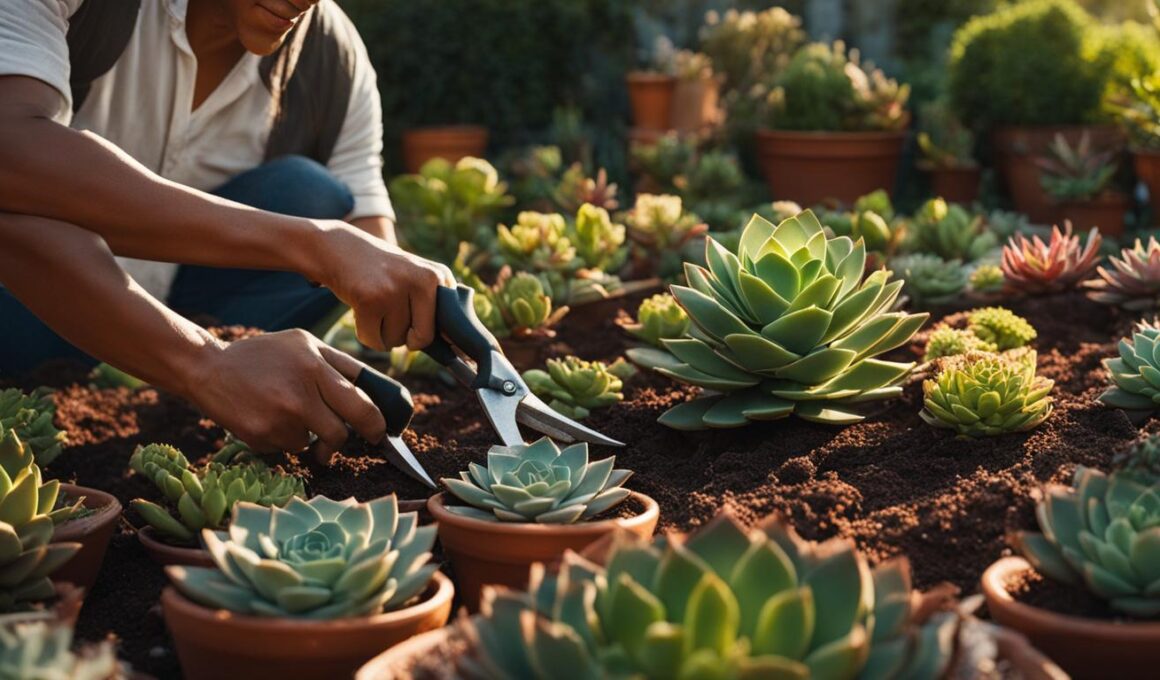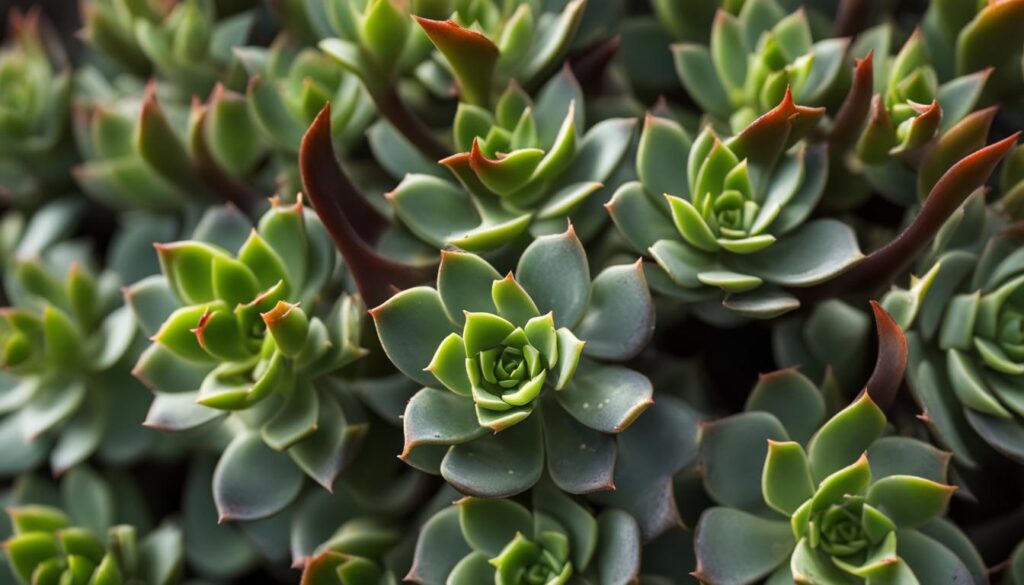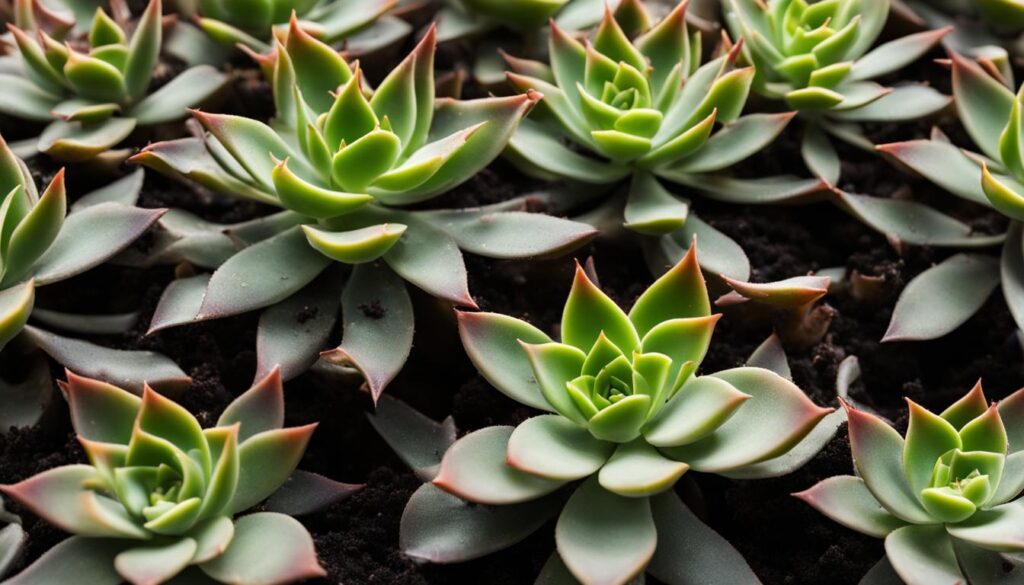Welcome to our master guide on how to clean up overgrown succulents effectively. If your succulents have become unruly and are in need of some tidying up, we’ve got you covered. In this guide, we will explore the importance of efficient succulent cleaning and provide you with expert tips on trimming overgrown succulents.
Post Summary
- Pruning trailing fishhooks succulents is crucial for their health, growth, and appearance.
- Regular pruning helps maintain an attractive succulent by preventing trails from touching the ground and reducing plant debris.
- Proper pruning techniques involve making precise cuts just below a leaf or node with clean and sharp cutting tools.
- Spring is the optimal time to prune trailing fishhooks succulents for the best results.
- Efficient succulent cleaning promotes plant health, controls size and shape, and stimulates fresh new growth.
Benefits of Pruning Trailing Fishhooks Succulent
Pruning trailing fishhooks succulents offers a multitude of benefits for their growth and overall appearance. By regularly trimming back the stems, you can promote the health of the plant, control its size and shape, and stimulate fresh new growth. Pruning also helps prevent the trails from touching the ground, making maintenance easier, and reduces plant debris in your garden or indoor space.
When you prune your trailing fishhooks succulent, you are effectively thinning out the stems, creating a more open and airy look. This not only contributes to the plant’s visual appeal but also allows for better air circulation around the leaves. Proper airflow helps prevent the onset of diseases such as fungal infections, keeping your succulent healthy and vibrant.
Controlling the size and shape of your trailing fishhooks succulent is another key benefit of pruning. By making precise cuts just below a leaf or node, you can guide the growth of the plant to achieve your desired shape. Whether you prefer a compact and bushy succulent or a more trailing and cascading appearance, pruning allows you to shape the plant according to your preferences.
“Pruning is an essential part of succulent care that promotes plant health, controls size and shape, and enhances the overall beauty of your trailing fishhooks succulent.” – Succulent Care Expert
Regular pruning of your trailing fishhooks succulent also helps to rejuvenate older growth and stimulate fresh new growth. By removing dead or overgrown parts, you create space and resources for the plant to produce new shoots and leaves. This leads to a healthier and more vigorous succulent that will continue to thrive and bring beauty to your space for years to come.
Benefits of Pruning Trailing Fishhooks Succulent
| Benefit | Description |
|---|---|
| Promotes Plant Health | Pruning allows for better airflow and reduces the risk of diseases. |
| Controls Size and Shape | You can guide the growth of the plant to achieve your desired appearance. |
| Stimulates Fresh Growth | Removing dead or overgrown parts encourages the production of new shoots and leaves. |
In summary, pruning your trailing fishhooks succulent offers numerous benefits, including promoting plant health, controlling size and shape, and stimulating fresh growth. By incorporating regular pruning into your succulent care routine, you can ensure the long-term vitality and beauty of your plant.
How to Prune a Trailing Fishhooks Succulent
Proper pruning techniques are essential for maintaining the health and appearance of your trailing fishhooks succulent. Follow these steps to ensure successful pruning:
- Choose the right tools: Use clean and sharp cutting tools to make precise cuts. Fiskar Floral Nips are recommended for clean and precise cuts.
- Timing is key: Prune your succulent during the spring when it is actively growing. Avoid pruning during the winter when the plant is resting.
- Inspect the plant: Before pruning, examine your succulent for any signs of stress or damage. Make sure the plant is not already under any stress before making cuts.
- Make precise cuts: To promote new growth and prevent a dense appearance, make cuts just below a leaf or node. This will encourage fresh growth and maintain an attractive shape.
- Protect yourself: Wear gloves to protect your hands from thorns or sharp edges while pruning.
Regularly maintaining and cleaning your pruning tools will contribute to their optimal performance. By following these pruning techniques, you can ensure the health and beauty of your trailing fishhooks succulent.
Pruning Techniques for Trailing Fishhooks Succulents
When it comes to pruning trailing fishhooks succulents, precision is key. By implementing proper pruning techniques, you can enhance the growth and appearance of your succulent. Here are a few essential pruning techniques:
- Pinch back the stems: Regularly pinch back the stems of your succulent to control its size and shape. This will prevent the trails from touching the ground and reduce plant debris.
- Remove dead or diseased parts: Prune any dead or diseased parts of your succulent to maintain its overall health. Removing these parts will also stimulate fresh growth.
- Thin out dense areas: If your succulent looks dense or overcrowded, thin out the stems by making cuts just below a leaf or node. This will create a more balanced and visually appealing plant.
- Practice regular maintenance: Make pruning a regular part of your succulent care routine. By consistently removing overgrown parts, you can prevent your succulent from becoming unruly.
Remember to always use clean and sharp cutting tools to avoid any damage to your succulent. With these pruning techniques, you can keep your trailing fishhooks succulent thriving and looking its best.
Potential After-Effects of Pruning Trailing Fishhooks Succulent
After pruning your trailing fishhooks succulent, it’s important to assess the growth and monitor any potential after-effects. This will help you determine if further pruning is necessary and ensure the overall health and vitality of your plant. Here are some key factors to consider:
Assessing Growth
Observe the plant for new growth emerging from the cut stems. This indicates successful pruning and the stimulation of fresh new growth. Look for new growth forking off from the bottom and middle of the plant, as this signifies a healthy and thriving succulent. Keep an eye out for any signs of stress or damage, such as wilting or discoloration. By closely monitoring the growth after pruning, you can make informed decisions regarding further maintenance.
Successful Propagation Tips
If you’re looking to propagate new plants from the pruned cuttings, follow these tips for successful propagation. Allow the cuttings to callous over for a few days before planting them in well-draining soil. This callousing process helps protect the cut end from rotting and promotes healthy root development. Plant the cuttings in a location that receives indirect sunlight and mist the soil lightly to keep it moist but not wet. With patience and proper care, you can successfully propagate new plants from your pruned trailing fishhooks succulent.
Remember to regularly assess the growth and adjust your pruning techniques accordingly. By carefully observing the progress of your succulent and following successful propagation tips, you can ensure the long-term health and beauty of your plant.
| Assessment Criteria | Observations |
|---|---|
| New Growth | New growth emerging from the cut stems |
| Forking Growth | New growth forking off from the bottom and middle |
| Signs of Stress | Wilting, discoloration, or other signs of stress or damage |
By carefully assessing the growth and following successful propagation tips, you can ensure the continued vibrancy and vitality of your pruned trailing fishhooks succulent. With these considerations in mind, you’ll be able to maintain a healthy and thriving plant that brings beauty to your space.
Conclusion
Pruning is a vital practice for revitalizing your succulents and ensuring their healthy growth. By removing dead or overgrown parts, you can stimulate fresh growth and maintain an attractive plant. Understanding the importance of pruning is key to keeping your succulents thriving.
With the right tools and techniques, pruning can be a simple and rewarding process. Always use clean and sharp cutting tools to make precise cuts just below a leaf or node. Spring is the optimal time for pruning trailing fishhooks succulents, as it allows for optimal results.
Take control of your succulent’s growth and transform it into a vibrant centerpiece for your outdoor space. Embrace the art of pruning and enjoy the benefits of revitalizing your succulents. Happy pruning!
FAQ
Why is pruning trailing fishhooks succulents important?
Pruning is essential to bring out their beauty, promote growth, and control their size and shape.
What are the benefits of pruning trailing fishhooks succulents?
Pruning promotes plant health, controls the size and shape of the succulent, stimulates fresh new growth, prevents trails from touching the ground, and reduces plant debris.
What are the proper pruning techniques for trailing fishhooks succulents?
Make precise cuts just below a leaf or node using clean and sharp cutting tools.
When is the best time to prune trailing fishhooks succulents?
Spring is the best time to prune for optimal results, avoiding winter pruning when the plant is resting.
How do I assess the condition of a trailing fishhooks succulent after pruning?
Look for new growth emerging from the cut stems, observe if the new growth is forking off the bottom and middle, and check for any signs of stress or damage.
How can I propagate pruned cuttings of trailing fishhooks succulents?
Allow the cuttings to callous over for a few days before planting in well-draining soil and providing indirect sunlight. Mist the soil lightly to keep it moist but not wet.
Can a Humidifier Help with Overgrown Succulents?
During winter, overgrown succulents might struggle to thrive. However, the amazing benefits using a humidifier during winter can help them flourish. By maintaining the right level of moisture in the air, a humidifier can prevent succulents from drying out and provide the optimal conditions for growth.











